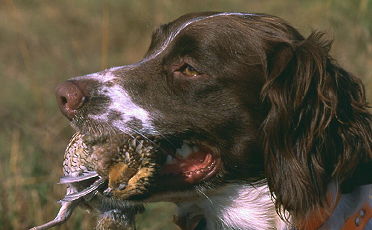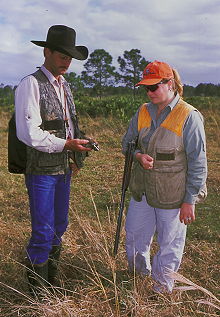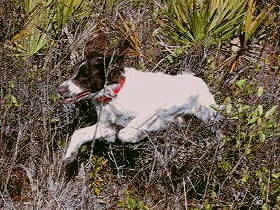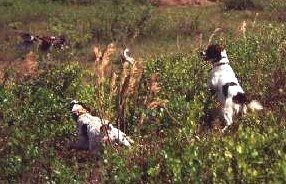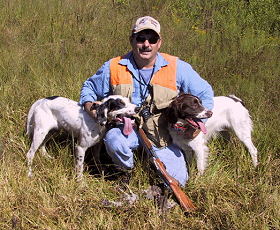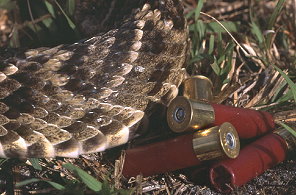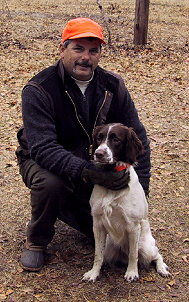 
Only a small group of upland hunters give the Sunshine State a second thought when it comes to hunting upland game with bird dogs. Florida, often referred to as the fishing capital of the world, is known more for itís fantastic shallow water angling than it is for itís wing shooting opportunities. It does not take one long to flip through a few hunting mags to see that Georgia takes all the media attention when it comes to a traditional southern style quail hunt - and rightly so. With the backdrop of a working plantation, the beautifully appointed lodges, mule drawn wagons transporting hunters, and guides/handlers on horseback - all inspire a tradition that has changed little in the last seventy five years.
Although Georgia does have plenty of hunting opportunities, the tradition does not stop at the Sunshine State's northern border. Florida supports an abundance of wildlife and waterfowl including: whitetail deer, black bear, wild hogs, bobcats, migratory birds, ducks, small game, bobwhite quail and snipe. Its vast south central region surrounding Lake Okeechobee is the headwaters of the Everglades and its "river of grass". This shallow, fresh water flow is Florida's life blood when it comes to the many species of wildlife and birds that migrate and inhabit this vast unspoiled area. Both Florida's east and west coasts are urban and developed. But not far out from the shadows of the Coastal high rises and shoreline condos is the "real Florida". A Florida steeped in a hunting tradition that goes back to the early
cattlemen and ranchers that cleared land, diverted water, and provided the edge habitat that wildlife thrive on.
"A spaniel by breed and a true hunter by heart, the springer shows little hesitation, driving into the thickest of palmetto patches - putting quail to wing with a style like no other flushing breed."
Native Quail
From the Florida Panhandle down through the Okeechobee watershed, there are countless numbers of game and cattle ranches that support healthy populations of wild quail. In addition to the ranches, there are also plantations that specialize in upland hunts - catering to the hunter with or without bird dogs. Most game ranches offer hog and whitetail deer along with the upland hunts - and chances are that a trophy largemouth bass pond might be close by. After all, it is South Florida. But the specialty is, without doubt, the quail. Licensed shooting preserves boast a long, six month season on quail spanning October through March - giving plenty of opportunity to both the visiting hunter and the resident to enjoy coveys throughout the winter months.
When serious bird hunters hear the term "shooting preserve", it conjures up notions of bird pens, day put birds, and flapping non-flyers. Not much fun for hunters and counter productive for dog training.
Working game and cattle ranches manage their quail populations in a much different fashion than the typical bird preserve that plants birds for the day hunter. With a wild population of native quail supplemented with an early release program, ranches can produce hold over coveys of near wild birds offering hunters a quality hunt that is very rare in today's "pay to hunt" preserve style operations. Of course, plenty of time and effort goes into food plot and habitat management along with ground predator control. This includes the removal of the non-native exotic trees and plants that strangle the native ground cover that
the quail so vitally need - for shelter and food. The edge cover that is so vital to the quails survival is put in place as a result of the land management that ranchers use to maintain their cattle and citrus crops. The end result of controlled burns and habitat restoration is the main reason that we have a legitimate population of wild birds - and some of the best wing shooting I have ever experienced in my many years of guiding and hunting upland game over bird dogs.
Quail Dogs
I have an extreme prejudice when it comes to choosing the breed of gundog that I prefer to hunt with - either personally or with paying clients. The field bred English springer spaniel is, by far, the one breed of bird dog that has the versatility, intensity, and stamina to adapt to any hunting situation that you choose to put them in. From the grouse and woodcock covers of Northwestern Maine, to the palmettos and live oak hammocks of Central Florida, I have successfully hunted field bred springers in all conditions and weather extremes.
A spaniel by breed and a true hunter by heart, the springer shows little hesitation, driving into the thickest of palmetto patches - putting quail to wing with a style like no other flushing breed. During the winter months, Florida's sub-tropical climate can range from forty degree mornings to seventy plus degrees in the afternoon. Periods of cool downs created by northern cold fronts that push south into the Sunshine State provide the best conditions for both hunter and bird dogs - the cooler the better. Even a well conditioned springer has its limitations during warmer hunt days. With the exception of the English pointer, it would take a good deal of conditioning for most of the flushing and pointing breeds to condition train to Florida's climate.
Because of the varied weather, the early morning hunts and the last few hours of afternoon shooting light are prime times to target quail. It is also the best time to find birds in large coveys. Nothing is more exciting than to put a springer down during the last forty-five minutes of shooting light and let the dog flush for the walking hunters. A dog with a good nose that hunts in control with a fairly tight pattern can keep two hunters very busy for most of the last hour of shooting.
"Even a slow day by Florida standards would allow the dogs to flush a dozen coveys - letting the dogs have at least a hundred bird contacts."
Non-slip Retriever
Nothing is more enjoyable than working a springer along a palmetto lined tote road or a patch of knee high broom grass - watching the dog pattern into the wind - with the anticipation of a wild flush of a couple dozen bobwhite quail. In a perfect world, a few loads of number seven and a half shot find feathers and the dog gets to make a few retrieves. Repeat this scenario five or six times in the first few hours of a hunt and chances are you wont have much dog left for the rest of the day.
Putting the dog in a thousand acre cover in warm conditions limits the time the hunt can last and tests the physical condition of the dog. The best use of a springer in the Florida quail fields, by far, is using the flush dog as a traditional non-slip retriever. By allowing the pointers and setters to find the birds, go on point and wait
for the hunters and guide to bring in the flush dog, you are hunting in a much safer situation. Plus you are giving the springer what he wants - a chance to aggressively flush the covey and a retrieve - if one or more birds go down. A hunt ran like this also gives the springers a longer period to hunt and you would only need two or three flush dogs for an entire day in the field. Of course, you would still need a half dozen pointing dogs to find the coveys. Even a slow day by Florida standards would allow the dogs to flush a dozen coveys - letting the dogs have at least a hundred bird contacts.
From a guides point of view, keeping the flush dog at heal until being released for the flush gives the hunters time to get in position thus limiting the chance for a poor shot choice. And again, you absolutely have to have pointers steadied to both wing and shot - as well as having the springer hunt in control. Low-flying birds and dogs chasing the covey rise spells disaster - if dogs are taking out late flyers or birds are running out and getting up where the dogs are chasing. Using the flush dogs as non-slip retrievers and having steadied pointers eliminates any dangerous situations.
Water Hazards
There is no off-season for rattlesnakes in Florida. And yes, the Eastern Diamondback can be found throughout the Sunshine State. But during the winter months they less likely to be an issue with bird dogs. Anyone who spends any amount of time in the fields training dogs or hunting considers snake boots required gear. Rattlesnakes avoid human contact and the old saying, "Leave them alone and they will leave you alone" - is very true. Bird dogs, however, present another problem. When dogs encounter snakes, they will often do a "snake-dance" around the snake. If the situation allows, the guide or handler can get in and pull the dog off. It is something you do not want to make a habit of doing but it is a form of de-snakeing. If you can find a live snake and someone crazy enough to handle it - while convincing the dog with an e-collar that is in
his best interest the snake be avoided, de-snakeing works. You would not consider this type of training your shinning moment as a trainer, but if it saves your dogs life, there is no reason not to.
Since most ranches have irrigation and canal systems, alligators are common in the canals . In fact, gators are common throughout Florida but rarely are an issue with bird dogs. Cooling off dogs in canals requires a watchful eye on the water for any sign of an approaching gator. Wild hogs also can be a danger to bird dogs. The wild hogs are common in Florida they are kept in check on most of the ranches that run quail hunts - but an odd encounter is always possible. The business end of a boar hog's razor sharp teeth can inflict a nasty and sometimes fatal cut to any dog and that includes the bull dogs that go out and intentionally catch hogs for hog hunters. Although ever present encounters with snakes, gators, and hogs are a rare instance, itís all part of hunting down here and anyone considering a bird hunt would be
smart to educate themselves to the possible dangers.
With that being said, Florida offers a fantastic opportunity to any upland hunter looking for a quality hunt with plenty of birds and a reasonable price tag. The game ranches pride themselves on the quality and quantity of birds along with the beautiful natural landscape that makes this part of "Old Florida" one of the top sportsman's destinations in the country.

|
|
|
| Bookstore | The Bookshelf | Advertise on SJ | Classifieds | Resources | NEW! Events | Letters | Archives | Spaniel Journal | |
